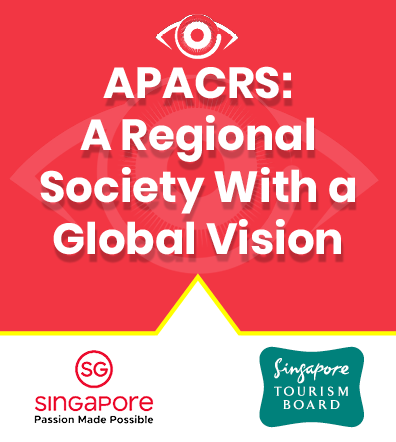Eyeworld Weekly Update |
Volume 21, Number 46 |
9 December 2016 |
- Iontophoretic treatment has positive early stage results
- Aerie fully enrolls Roclatan's Mercury 2 Phase 3 registration trial
- ST266 enters Phase 2 study for allergic conjunctivitis
- UVB exposure associated with reduced risk of myopia
- Roski Eye Institute first in California to train certified ophthalmic techs
Iontophoretic treatment has positive early stage results
An iontophoretic dexamethasone phosphate treatment for ocular inflammation and pain in post-surgical cataract patients has "promising data" from the third stage of a Phase 1b/2a study, developer EyeGate Pharmaceuticals (Waltham, Massachusetts) said in a press release. Stage three of this multicenter, open-label clinical trial enrolled 30 subjects who have undergone cataract surgery with implantation of a posterior chamber IOL. Patients were divided into three cohorts wherein they received iontophoretic doses of EGP-437 at either 4.5 mA-min or 14.0 mA-min, or a placebo at 14.0 mA-min. Subjects in the EGP-437 14.0 mA-min cohort were administered treatments on day 0 (preoperative), day 1, and day 4. The other two cohorts were administered treatments on day 0 (postoperative), day 1, and day 4. Subjects who were administered 4.5 mA-min dosing (3.0 mA for 1.5 minutes) realized the greatest benefit, with 30% and 80% of patients at day 14 and day 28, respectively, achieving complete reduction or an anterior chamber cell (ACC) count of 0, compared to the placebo group where 80% of subjects had to be rescued and only 10% had an ACC count of 0 on day 28. EyeGate plans to initiate a randomized, double-masked, placebo-controlled study in the first half of 2017.
Aerie fully enrolls Roclatan's Mercury 2 Phase 3 registration trial
Patient enrollment in a second Phase 3 registration trial (Mercury 2) for Roclatan (netarsudil/latanoprost ophthalmic solution) 0.02%/0.005% is now complete, developer Aerie Pharmaceuticals (Bedminster, New Jersey) said in a press release. Roclatan is being developed to lower IOP in patients with glaucoma or ocular hypertension. Roclatan is a fixed dose combination of Rhopressa (netarsudil, Aerie) and latanoprost. Total patient enrollment has exceeded the 690 patients needed for this three-arm study, designed to demonstrate superiority of Roclatan solution to each of its two components, all dosed once daily in the evening, according to Aerie. Enrolled patients had maximum baseline IOPs ranging from above 20 to below 36 mm Hg. Mercury 2 is a 90-day registration trial with a topline efficacy readout expected in the second quarter of 2017.
ST266 enters Phase 2 study for allergic conjunctivitis
A novel secretome, ST266, has entered Phase 2 studies for the treatment of allergic conjunctivitis, according to developer Noveome (Pittsburgh). ST266 uses paracrine signaling and has been found to help promote cellular homeostasis, modulate inflammation and regenerate damaged cells, the company said. The Phase 2 multicenter, double-masked, randomized, placebo-controlled trial will assess the efficacy, safety, and tolerability of ST266 ophthalmic drops for the treatment of the signs and symptoms of allergic conjunctivitis. The primary endpoint of the study will measure ocular itching and conjunctival redness over time following an allergen challenge. Topline Phase 1 study data showed the compound to be well tolerated, without any drug-related adverse events.
UVB exposure associated with reduced risk of myopia
Higher ultraviolet B (UVB) radiation exposure, directly related to time outdoors and sunlight exposure, was associated with reduced odds of myopia, and exposure to UVB between ages 14 and 29 years was associated with the highest reduction in odds of adult myopia, according to a press release from the London School of Hygiene & Tropical Medicine. Astrid Fletcher, PhD, and colleagues examined the association of myopia with UVB radiation, serum vitamin D concentrations, and vitamin D pathway genetic variants, adjusting for years in education. The study included a random sample of participants 65 years and older from six study centers from the European Eye Study. Of 4,187 participants, 4,166 attended an eye examination including refraction, gave a blood sample, and were interviewed by trained fieldworkers using a structured questionnaire. After exclusion for various factors, the final study group included 371 participants with myopia and 2,797 without. The researchers found that an increase in UVB exposure at age 14 to 19 years and 20 to 39 years was associated with reduced odds of myopia; those in the highest tertile (group) of years of education had twice the odds of myopia. No independent associations between myopia and serum vitamin D3 concentrations or variants in genes associated with vitamin D metabolism were found. An unexpected finding was that the highest quintile (group) of plasma lutein concentrations was associated with reduced odds of myopia. "The association between UVB, education, and myopia remained even after respective adjustment. This suggests that the high rate of myopia associated with educational attainment is not solely mediated by lack of time outdoors," Dr. Fletcher said. "As the protective effect of time spent outdoors is increasingly used in clinical interventions, a greater understanding of the mechanisms and life stages at which benefit is conferred is warranted."
Roski Eye Institute first in California to train certified ophthalmic techs
The University of Southern California (USC) Roski Eye Institute (Los Angeles) will offer the first educational program in California, one of only 14 programs nationwide, to train certified ophthalmic technicians with its Ophthalmic Technician Education Program (OTEP) beginning January 2017, the university said in a press release. The USC OTEP "will create highly skilled allied health professionals who guide patients and families on understanding their vision conditions, ensure compliance with treatment protocols, and conduct various tests and procedures that inform ophthalmologists in the diagnosis and treatments of eye diseases and vision conditions," the university said of its 21-month program.
 Licensed Publications |
Licensed through ASCRS American Society of Cataract and Refractive Surgery, 4000 Legato Road, Suite 700, Fairfax, VA 22033-4003, USA.
All rights reserved. The ideas and opinions expressed in EyeWorld Asia-Pacific Weekly News do not necessarily reflect those of the ASCRS�ASOA or APACRS. Mention of products or services does not constitute an endorsement by the ASCRS�ASOA or APACRS. Copyright 2008, EyeWorld News Service, a division of ASCRS Media. |



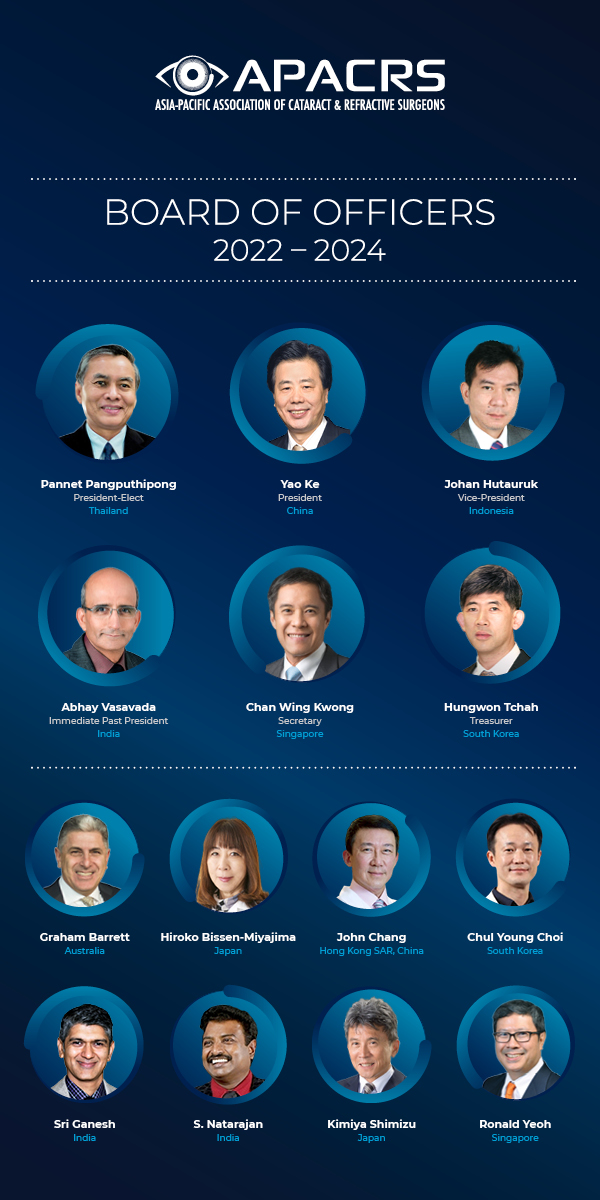
 EyeSustain Update
EyeSustain Update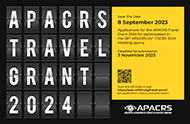 2024 APACRS TRAVEL GRANT
2024 APACRS TRAVEL GRANT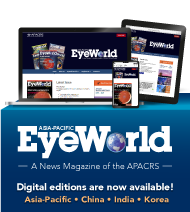 Digital EyeWorld
Digital EyeWorld VOL. 39 (2023), ISSUE 3
VOL. 39 (2023), ISSUE 3  Membership Information
Membership Information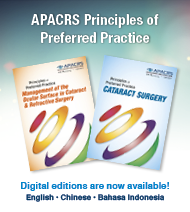 APACRS Principles of Preferred Practice
APACRS Principles of Preferred Practice